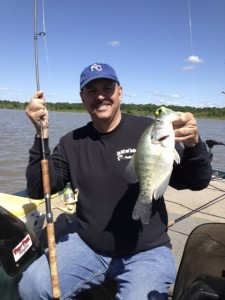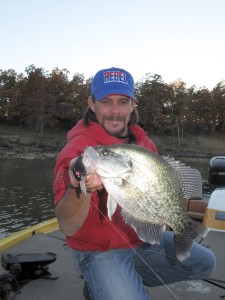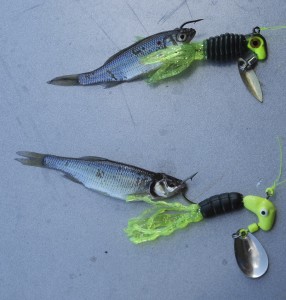By Kenneth L. Kieser
Northeast News
February 18, 2013
The old adage, “You can’t teach an old dog new tricks,” has been the downfall of many fishermen. I fall into this stubborn group of anglers that never change tactics, especially in spring when weather conditions dictate changing crappie tactics. My old ploy was to anchor over crappie beds and dip live minnows. A young fisherman recently changed my way of thinking about spring crappie.
I seldom miss an opportunity to crappie fish, especially with friends. I gratefully accepted Jeff Faulkenberry’s generous invitation to join him for a post-spawn trip on Truman Lake in late April, 2012. My friend is an accomplished fishing guide out of Bucksaw Marina on Missouri’s Truman Lake and radio personality on Johnny Everhart’s Missouri Outback radio show.
Problem was, a big warming trend had set and the wind was blowing, making water conditions murky, not ideal conditions. These are the times when a professional fishing guide earns their money.
We started fishing around submerged trees and bushes in open water with some luck, but not what Faulkenberry was looking for. We moved farther down the lake and started fishing closer to cover; in fact, as close as you can get.
“Let your Roadrunner bounce down the sides of each stump and tree,” Faulkenberry said. “I think the bigger crappie may be hugging bark today.”
We immediately started catching crappie. His idea was correct and the crappie cooperated with this young guide who was teaching a veteran fisherman of over 50 years a new trick.
We had caught several crappie that were indeed “hugging bark” when my lightweight rod suddenly doubled. I mumbled something about a nice bass when the sun illuminated silver flashing just under the surface. I had hooked a bigger crappie that was diving for tree limbs. I could only hold on and fight out the fish, while putting more pressure on four-pound test line than the law of fishing allows. Luckily Faulkenberry had a long-handled net and soon I held a 2-1/2 pound crappie, the biggest of my fishing career. The old dog savored this new trick while looking over a big, beautiful crappie that was immediately released.
SPRING CRAPPIE FISHING – Most crappie are caught in the spring when mature fish move into the shallows to spawn. Just about any fisherman can find enough crappie to fill an early-season fish sack, but finding spring crappie in big numbers is a different story.
Crappie move from the shallow to deeper water when warmer temperatures take over. Submerged standing timber found on deep flats with submerged creek channels becomes a favorite crappie haunt. They have more bait fish and a safe place to survive.
Strangely enough, of the hundreds of trees scattered around a flat, only a few may hold crappie. Experienced fishermen know to fish around the trees with more branches. Heavier cover attracts more baitfish and thus, crappie.
“We ironically only caught crappie around the black trees or stumps,” Faulkenberry said. “That was the pattern I established and it paid off in two limits of bigger fish. Tomorrow the crappie may switch to lighter colored trees, only they can tell you through bites. We were fishing shallow too, because warmer weather spreads out the thermocline, pushing the bait fish up shallow and the crappie followed. This is why Truman Lake fisherman catch shallow-water crappie in the summer too.”
Had Faulkenberry’s warm-water tactic failed, he would have spider-rigged several Roadrunner jigs or Mid-South Tackle tubes in blue chartreuse or black and pink colors and trolled to cover more water in eight to 10-foot depths over submerged creek channels. Spider rigging is using several jigs at once on custom-made harnesses.
Water temperature is an important factor. Faulkenberry recently marked a big school of crappie on his graph, but the water temperature read 40 degrees. The water temperature rose to 43 degrees a couple hours later and the crappie started hitting and everyone limited out with 30 fish in less than an hour.
MORE NEW TRICKS – “I go back into the main feeder creeks,” said Todd Huckabee, Oklahoma fishing guide and professional tournament fisherman. “During early spring most crappie will be on the first break line closest to the bank. A break line is where the water may drop from six to eight feet or eight to 10 feet or usually the gradual slant of an old creek channel. The crappie stage in break lines before spawning conditions are correct. This is normally one of the best bites each year.”
Huckabee ties on two jigs 15 inches apart. The top jig is a 1/8th ounce Lindy jig with a two-inch beaver tail and the bottom jig is 1/4th ounce with a two-inch beaver tail on. These are bigger baits but that time of year no fish have yet spawned and shad tend to be bigger. Bigger profile lures are more visible in muddy water common to spring.
“I hold one rod in each hand and put my trolling motor on a slow setting,” Huckabee said. “I point my boat into the wind, allowing the boat to just creep along slowly. I hold my rods steady along the break lines and we catch a lot of crappie. These break line areas don’t really have to have cover like brush, but we do catch crappie from junk like submerged bushes or crappie beds. This technique is often called strolling.”
Huckabee’s signature 11-foot pulling rod he designed for this technique features 10-pound test line.
“You feel the bite better on a stiffer rod and heavier line,” Huckabee said. “Most fishermen think you feel the bite better on an ultra light rod, but that is not true. Lighter equipment actually absorbs the shock of the bite. The other factor is swinging bigger crappie in off the bite with a heavier rod, bigger hook and heavier line. This means not reeling and dropping back down to the same productive depth.”
Huckabee, too, claims that using lighter line and smaller jigs in clear water is a myth. He uses the same heavy equipment in all water conditions with good success while claiming the crappie could care less how big your line is.
For more information about fishing for crappie on Truman Lake with Faulkenberry, call Bucksaw Marina, (660) 477-3900 or e-mail them at info@bucksaw.com.



















